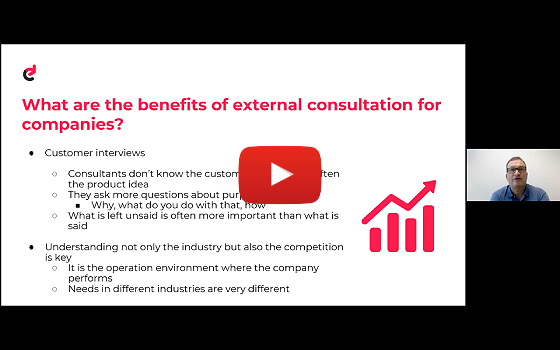Today we are coming back with another article written by our Senior Digitalization Consultant, Kris Honkola. Kris Honkola is a result-oriented business and solution consultant at Espeo Software, in addition to which he also works as a project manager for our Finnish customers.
This time, Kris shares his views on increasing the value of the business and focuses in a new article on e.g. the following topics:
- Importance of turnover optimization
- The complexity of operational efficiency
- Measuring customer satisfaction
Read also: Identifying the best digital investments: Use Cases
Make sure to check out all the articles from the consulting series:
- How to identify what digital technologies to invest in [Part 1]
- Identifying the best digital investments: Use Cases [Part 2]
- Ideation. Gaining advantage with the ideas of the Espeo Consulting team [Part 4]

The importance of revenue optimization in business value assessment
When I first introduce the concept of Business Value Assessment to my clients, most of them expect me to talk only about increased sales. Although the sales increase is important, it is not the only area where business value can be realized. Revenue optimization is another significant element which should be in focus. Let us consider some examples.
As a definition, revenue optimization is a combination of pricing, demand, and marketing strategies that are used to maximize revenue growth. It requires analysis of the price points and sales channels, among others.
Following the above definition, one can agree that increased sales are one of the aspects of revenue optimization. However, the overall focus should be on the profitable sales that impact the company’s profitability. Therefore, the conversations can get extremely complicated amazingly fast while evaluating the sales and their profitability during business value assessment.
Here are few questions to consider:
- Does the company have a capacity to produce more profitably?
- Do the logistics support additional sales?
- Does the current target market offer an opportunity for additional profitable sales?
It has been my discovery that many organizations don’t analyze their offerings with profit in mind when it comes to optimizing the revenue. Moreover, companies are unaware of the profitability of the different offerings they have.
The Improved Financial Performance covers most of the cost saving components. These include: reduced work, more efficient work, fewer mistakes, lower customer contact costs, and more. Companies have a rather good understanding of their cost structures of different processes, so this is usually the easiest part of the BVA process.
The complexity of operational efficiency
The operational efficiency is a simple concept in theory. Make people do their work better with fewer errors. While it is relatively easy to calculate the cost of errors, wrong orders, missed appointments, and many other issues, these metrics might not tell the complete story.
How many customers might the company lose because of the bad experience with the shipping? What is the total cost of the secondary implications of doing things better in the first time, the bad customer experience is shared much more than a good one?
The Business Value Assessment workshops help our customers answer these questions.

Calculating the employee and customer satisfaction
Satisfaction is one aspect of business value assessment I get the most questions about. Answering the question of how you can place value on employee or customer satisfaction is not that straightforward. While customer satisfaction can be calculated in some industries, employee satisfaction is harder to evaluate.
Let’s take a retail company that I have worked with as an example. We were implementing a new customer interaction tool for the retail workers in their physical stores. The purpose of the tool was to give the customers ideas of how the clothing would look on them. The feedback from the market was positive – customers enjoyed the implemented solution and purchased more products. Nevertheless, after a few months of use, the employees that were initially using the tool started to leave the company.
As a result, the organization had to hire more and more people to replace the departed employees. There were no exit interviews, so the company didn’t know the reasons for the departure of their employees. Thanks to the business value assessment workshop, we have calculated the cost of replacing the employees and the cost of potentially lost sales during the time when there was no one to use the tool. Making use of the total cost of such a phenomenon as part of my Return of Investment calculations helped with opening the eyes of upper management. In the end, Espeo got to implement more user-friendly tools for the company.
In the next article, we will look at the financial calculations of a typical business value assessment.





